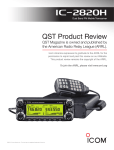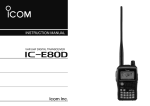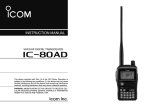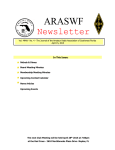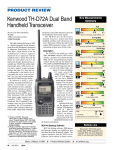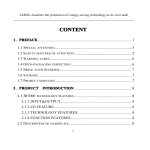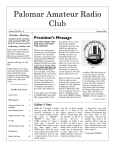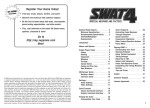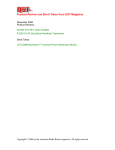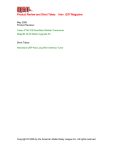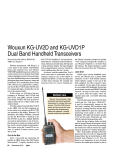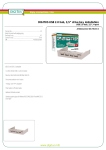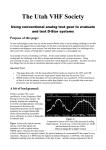Download QST Review - Icom America
Transcript
Key Measurements Summary PRODUCT REVIEW ICOM IC-80AD Dual Band Handheld Transceiver Reviewed by Steve Ford, WB8IMY QST Editor One of the main stumbling blocks to widespread adoption of D-STAR technology is cost, especially in today’s economy. At about $100 less than its sibling, the IC-92AD, the new IC-80AD transceiver marks ICOM’s attempt to lower the economic threshold.1 But is it enough to get more hams to open their wallets for D-STAR? Perhaps, especially when you consider that there is much more to the IC-80AD than D-STAR. One Tough Radio When you first pull the IC-80AD from its box, you realize that this radio was designed with rugged use in mind. There are no plastic chassis here; the case is aluminum with a finish that makes is easy to grip when wet. Speaking of wetness, the IC-80AD carries a Class 4 Japanese Industrial Standards (JIS) rating that means, among other things, that the radio is splashproof, but is not waterproof. For amateurs involved in emergency communications, durable construction is not a trivial feature. They want radios they can trust to withstand brutal conditions. The IC-80AD has a sizeable LCD display that could suffer scratches, but otherwise I’m confident the rig could survive a fair amount of abuse. 0.16 76@10 MHz I3 67@10 MHz Rx 90 Receiver 3rd-Order Dynamic Range (dB) 58@20 kHz* I3 60@20 kHz* 70 Rx 40 Receiver 3rd-Order Dynamic Range (dB) 65 ChRej 50 62 90 Adjacent Channel Rejection (dB) 105 IF 60 123† 110 IF Rejection (dB) 113† Img 60 Image Rejection (dB) 134† 110 375 Snd 100 800 Audio Output (mW) 244 244 T-R 250 pr042 50 Tx-Rx Turnaround Time (ms) Key: Extended Receive Coverage 2M † Off Scale A major difference between the IC-80AD and the IC-92AD is that the ’92AD includes a dualwatch feature so that you can listen to a main and sub receiver simultaneously. With the IC-80AD you can listen to one band at a time. Another difference is that the IC-80AD * Measurement noise limited at value shown. 70 cm Bottom Line With the IC-80AD, ICOM offers a less expensive alternative for hams interested in getting involved with D-STAR digital operation. It’s also a full-featured analog FM dual-band handheld and includes a wide coverage receiver. 1G. Pearce, KN4AQ, “ICOM IC-92AD Dual Band Handheld Transceiver,” Product Review, QST, Sep 2008, pp 39-43. QST Product Reviews are available on the Web at www.arrl.org/ members-only/prodrev/. 40 December 2009 0.1 Receiver Sensitivity (12dB SINAD, µV) doesn’t have the simple band scope display found in the ’92AD. From a reception standpoint, the IC-80AD is a “dc-to-daylight” rig spanning 500 kHz to almost 1 GHz. I had the pleasure of taking the IC-80AD on a family vacation and its extended receive coverage really came in handy. Reception below 50 MHz with the standard-issue flexible helical antenna is fairly limited. Despite this handicap, I was still able to listen to strong local AM broadcast stations as well as shortwave powerhouses such as Radio Havana. With an SMA-to-female BNC or SO-239 adapter the IC-80AD can be connected to a larger antenna. This boosts reception substantially, but it also raises the specter of front-end overload since the IC-80AD really isn’t designed to expect a sea of strong HF/ MF signals. FM broadcast and AM aircraft monitoring was a breeze, as was eavesdropping on public service frequencies. Once again, improving on the flexible antenna makes a big diff erence. For VHF+, I used a 1 ⁄4 wavelength 2 meter magnetic mount antenna while cruising the high-ways. With the IC-80AD’s Mark J. Wilson, K1RO 0.19 SINAD 0.25 Product Review Editor [email protected] flexible scanning functions there was no end of stations to fill the memory channels. Speaking of memory, the IC-80AD allows you to store your scanning discoveries in more than 1000 channels that you can configure in 26 separate groups. Alphanumeric tagging allows you to keep track of the memory channel contents when your own wetware memory fails you. The IC-80AD has NOAA weather radio frequencies preprogrammed in dedicated memory slots. You just press the M/CALL button several times until you select the weather channel mode, then rotate the dial to select the desired station. There is a weather alert function that commands the IC-80AD to monitor the selected weather channel every 5 seconds, listening for a NOAA weather alert tone. When it detects the tone, you hear a persistent beep. The only downside of monitoring with the IC-80AD is its very small speaker. It produces a tinny sound that is prone to distortion at higher volume levels. In most instances I used earbuds or a headset for improved fidelity. If you plan to use the IC80AD in the car, adding an external speaker is a good idea. Analog FM The IC-80AD did a respectable job with analog FM on both 2 meters and 70 cm. Transmit audio reports were consistently good. With selectable RF output levels at 5, 2.5, 0.5 or 0.1 W, you have the option of using full power in fringe areas, or extremely low power when you need to squeeze the last drop of life from the battery. I generally operated the IC-80AD at 2.5 W, which worked well in just about every application. On a few occasions I needed the 5 W boost, but I noticed that the radio became rather warm to the touch. Naturally, the IC-80AD offers a huge array of features for analog operation including CTCSS (continuous tone coded squelch system) encoding and decoding and digitally coded squelch (DCS) functionality. CTCSS decoding was particularly convenient when I took the IC-80AD on the road. Many repeaters require CTCSS access and retransmit the low-frequency audio tones on their outputs. If the repeater doesn’t announce the CTCSS frequency, or if you don’t have an ARRL Repeater Directory or TravelPlus software at hand to look it up, the IC-80AD can decode the CTCSS tones as they are transmitted and display the results. Digital Operating with D-STAR I’ve dabbled in D-STAR before, but the IC-80AD provided my first opportunity to try it for an extended period. For the Table 1 ICOM IC-80AD, serial number 0501001 Manufacturer’s Specifications Measured in ARRL Lab Frequency coverage: Receive, 0.495-823.990, Receive, FM, FM narrow, AM, DV, 849-868.990, 894-999.990 MHz; as specified. WFM, 0.495 transmit, 144-148, 420-450 MHz. 809.990 MHz. Transmit, as specified. Modes: FM, FM narrow, AM (receive only), As specified. WFM (receive only), DV. Power requirements: 10-16 V dc. Receive, Receive (max vol, lights on, no signal): 170 mA typical (215 mA DV), standby, external 13.8 V dc, 400 mA; 8.1 V 62 mA typical (106 mA DV), power save, measured battery voltage, 200 mA; 30 mA typical (38 mA DV); transmit, power save, 49 mA. 2.1 A (max, high power).† Transmit, 13.8 V dc at 2 A max; high/med/low/s-low with battery: 146 MHz: 1.80/1.13/0.63/0.45 A; 440 MHz: 2.04/1.46/0.73/0.43 A.‡ Receiver Receiver Dynamic Testing FM sensitivity: 12 dB SINAD, 1.6-30 MHz, 0.4 µV; For 12 dB SINAD, 29 MHz, 0.16 µV; 30-118 MHz, 0.25 µV; 118-174 MHz, 0.14 µV; 52 MHz, 0.18 µV; 146 MHz, 0.16 µV; 174-350 MHz, 0.32 µV; 350-470 MHz, 0.16 µV; 222 MHz, 0.21 µV; 440 MHz, 0.19 µV; 470-600 MHz, 0.32 µV; 600-999.99 MHz, 0.56 µV. 902 MHz, 0.25 µV. WFM sensitivity: 0.495-108 MHz, 1 µV; 100 MHz, 1.2 µV. 175-222 MHz, 1.8 µV; 470-770 MHz, 2.5 µV. AM sensitivity: 10 dB S/N, 0.495-5 MHz, 1.3 µV; 10 dB S+N/N, 1-kHz, 30% modulation: 5-29.995 MHz, 0.56 µV; 118-137 MHz, 0.5 µV; 1 MHz, 0.53 µV; 3.8 MHz, 0.42 µV; 222-247 MHz, 0.79 µV; 247-329.995 MHz, 1 µV. 14 MHz, 0.41 µV; 29 MHz, 0.42 µV; 50 MHz: 0.5 µV; 120 MHz, 0.41 µV; 146 MHz, 0.38 µV; 222 MHz, 0.48 µV; 440 MHz, 0.46 µV. DV sensitivity: VHF (144-148 only), 0.22 µV; Not tested.* UHF (420-450 MHz only), 0.22 µV. FM two-tone, third-order IMD dynamic range: 20 kHz offset: 29 MHz, 60 dB; Not specified. 52 MHz, 64 dB; 146 MHz, 58 dB; 222 MHz, 59 dB; 440 MHz, 60 dB; 902 MHz, 65 dB.** 10 MHz offset: 146 MHz, 76 dB; 440 MHz, 67 dB. FM two-tone, second-order IMD dynamic range: 146 MHz, 72 dB. Not specified. FM adjacent-channel rejection: Not specified. 20 kHz offset: 29 MHz, 60 dB; 52 MHz, 58 dB; 146 MHz, 65 dB; 222 MHz, 62 dB; 440 MHz, 62 dB; 902 MHz, 57 dB. Spurious response: VHF, 60 dB; UHF, 50 dB. IF rejection, 29 MHz, 71 dB; 52 MHz, 31 dB; 146 MHz, 105 dB; 222 MHz, 112 dB; 440 MHz, 123 dB; 902 MHz, 96 dB. Image rejection, 29 MHz, 93 dB; 52 MHz, 87 dB; 146 MHz, 113 dB; 222 MHz, 440 MHz, >134 dB; 902 MHz, 2 dB. Squelch sensitivity: Not specified. At threshold, VHF, 0.41 µV; UHF, 0.45 µV. Audio output: >300 mW at 10% THD into 8 Ω. 375 mW at 10% THD into 8 Ω; 2.7% THD at 1 VRMS. Transmitter Transmitter Dynamic Testing Power output: VHF and UHF, 5.0 W high; With battery pack or external 13.8 V dc: 2.5 W med; 0.5 W low; 0.1 W s-low. VHF, 5 / 2.6 / 0.5 / 0.1 W. UHF, 4.9/ 2.5 / 0.5 / 0.1 W. Spurious signal and harmonic suppression: VHF, >70 dB; UHF, >70 dB. >60 dB (high, medium), –13 dBm (low, s-low). Meets FCC requirements. Transmit-receive turnaround time (PTT release Squelch on, S9 signal: VHF, 244 ms; to 50% of full audio output): Not specified. UHF, 244 ms. Receive-transmit turnaround time (“tx delay”): VHF, 72 ms; UHF, 70 ms. Not specified. Size (height, width, depth): 4.1 × 2.3 × 1.3 inches; weight, 10.3 ounces. Price: IC-80AD, $450; HM-189GPS speaker/mic, $200. †BP-217 battery pack (7.4 V, 1500 mAh Li-ion) and BC-167 battery charger supplied. Available options: Replacement BP-217, $90; BC-139 desktop drop-in rapid charger (2.5 hours), $100; BP-216 battery case (2 AA cells; TX power limited), $35; CP-19R cigarette lighter cable with filter, $40; OPC-254L external dc power cable, $15. ‡Current consumption was typically 5 mA higher in receive and 50 mA higher on transmit in DV mode. *No PN9/GMSK signal generator was available at the time. **20 kHz offset measurements were noise limited at the values shown. December 2009 41 a DV Dongle connected to their computers. Another good investment is the new Nifty E-Z Guide to D-STAR Operation by Bernie Lafreniere, N6FN. The Guide gives you practical instruction on how to use this innovative technology. It was a great help during my review. You’ll find it for sale in the ARRL online store at www.arrl.org. On the Air with D-STAR Figure 1 — The ICOM CS-80/880 cloning software makes it easy to configure the IC-80AD for D-STAR operation. uninitiated, D-STAR is a digital protocol developed by the Japan Amateur Radio League (JARL). Most hams think of it as a form of digital voice, but D-STAR is also capable of transporting any sort of data you desire. The IC-80AD supports the D-STAR “DV” mode, which transmits digital voice concurrent with a low speed (1200 bps) data stream. At 1200 bits per second you aren’t going to swap large files or surf the Internet, but you can efficiently communicate other information such as short text messages and GPS position data. In fact, ICOM offers a microphone equipped with a GPS receiver (the model HM-189GPS), but I did not test it for this review. (We covered the similar HM-175GPS speaker/mic in the IC-92AD review. Since that review was published, ICOM has substantially reduced the price of these accessories.) D-STAR operating is substantially different from analog FM, so much so that the learning curve is rather steep for most individuals. There are some similarities to packet radio in which call signs are used as digital addresses. To use a D-STAR repeater, for instance, you need to program its call sign into the radio beforehand. Then, your transmitted data (included your digitized voice) will be routed appropriately through the system, either locally or through gateways to distant repeaters. You can talk to other D-STAR users “in the open” (similar to conventional analog FM operation in which everyone can hear all the stations), or you can use call sign routing to keep your radio quiet when you’re not communicating with specific stations. Call sign routing keeps your radio squelched until someone directly addresses you by putting your call sign in the “your call” field 42 December 2009 of their radio. Then you hear them, and only them, until you turn off call sign squelch, but everyone else listening can still hear both sides of the conversation. You can even set the radio to respond only when specific stations are on the air. Operating Aids The free ICOM CS-80/880 cloning software for Windows (Figure 1) is a blessing when you need to set up multiple D-STAR system call signs. That’s not to say that you can’t program the radio based on the instructions in the IC-80AD user manual, but it is slow going. By investing in a data cable and downloading the free software (www. icom.co.jp/world/support/download/ firm/), you’ll find it much easier to enjoy D-STAR with the IC-80AD. For this review I used a serial data cable, the OPC-1529R ($16), to connect the IC80AD to my computer. If your computer lacks serial ports, you can try the OPC-478UC USB cable ($50), but the drivers included with the cable don’t support Windows Vista. For Vista drivers you’ll need to visit www. icomamerica.com/en/support/kb/Article. aspx?ArticleNumber=812A2A454A on the ICOM Web site. Note that the optional RS-92 PC remote control software for the IC-92AD does not work with the IC-80AD. With the IC-80AD and companion ID-880 mobile, ICOM introduced a new DR mode to make programming easier. It adds the ability to designate up to 300 D-STAR repeaters as additional memories that can be addressed quickly. Unfortunately, DR mode is not compatible with add-on DPLUS software, commonly used to link D-STAR repeaters, nor with stations accessing the network with So what was it like to operate D-STAR with the IC-80AD? In a word, fascinating. I programmed several D-STAR repeaters for my destination cities prior to leaving for vacation. On the road I used the open CQCQCQ mode to scare up conversations on several systems. While in Dayton, Ohio, I listened to a D-STAR roundtable on the W8BI system. There was never any doubt about who was transmitting because I could see their call signs on the IC-80AD display. Some transmissions were also accompanied by short lines of text declaring names or locations. The voice characteristics can be unusual at times, with some voices having what might be described as a compressed, “robotic” quality. This isn’t a pronounced effect, but it is noticeable if you listen closely. And unlike analog FM with which signals can still be understood in noisy conditions, D-STAR transmissions are allor-nothing propositions. While listening to conversations when mobile, for example, voices would abruptly drop out for several seconds at a time, and then suddenly return. When I reached the edge of a repeater system’s coverage, I fell off a digital cliff. One moment the repeater was there; the next moment it wasn’t. Balancing Cost and Benefit Compared to ICOM’s top-shelf IC92AD, the IC-80AD is a less expensive way to get started in D-STAR and its analog features are certainly attractive. Current ICOM owners will appreciate that it shares accessories and connectors with other models such as the IC-W32A, IC-T90A and IC91AD, making the switch less painful. With an average street price of $450, however, the IC-80AD still costs significantly more than a comparable dual-band analog-only handheld transceiver. Are the benefits of D-STAR worth the higher price? That decision depends on how much you value having the ability to participate in the D-STAR network and whether you are willing to invest the time necessary to become familiar with D-STAR technology. Manufacturer: ICOM America, 2380 116th Ave NE, Bellevue, WA 98004; tel 800872-4266; www.icomamerica.com.




